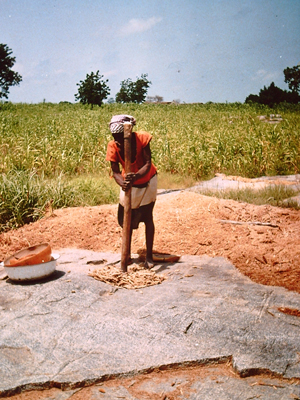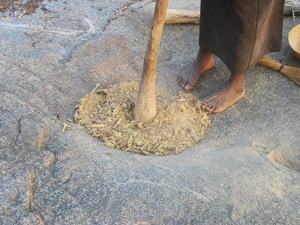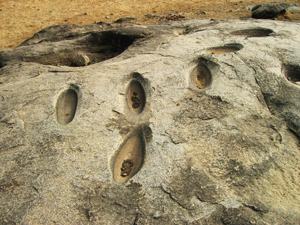 |
 |
|
Pounding millet cobs in a rock mortar |
|
Franz Kröger
Old Oval Grooves and Cylindrical Hollows in Granite Outcrops
Most of our readers may have discovered elongated oval grooves or deeper cylindrical holes
in some granite outcroppings of Bulsaland. Further details, such as their exact function or the
time of their creation, are not known to us.
 |
 |
|
Pounding millet cobs in a rock mortar |
|
The round deep holes may well have been used as "mortars" because today some compounds (for example, in Wiaga Badomsa) entirely renounce the large wooden mortars and use the round rock holes to remove the husks from millet grains and maize kernels or to crush shea kernels with a pestle. It is more difficult to determine the function of the elongated grooves. In their smallness and narrowness they do not seem to be suited for grinding millet grains.
Moreover, today's flat grinding stones (Buli nimbiik) or old quartz balls are built into
ancestral mud-shrines as sacrificial spots and fit poorly into the rock grooves. Most likely
leaves, roots or charcoal were ground in them to produce medicine.
We can only speculate about the age of the grooves. Maybe they originate in a time when
wooden mortars and grinding rooms were not yet used, and perhaps this time is not very far
back. For example, according to Akanming (d. 1989), an old man and soothsayer, there had
not been any wooden mortars in his youth.
 |
|
Oval grooves |
O. Davies, a British archaeologist who travelled through northern Ghana for the Department
of Archaeology of Legon, discovered similar traces of the past near Wa (1970, p 164th):
... There are a few long oval grooves; also some cylindrical hollows ... 6" across and 16-18" deep with
rounded bases, each at the base of a shallow basin wide which is covered by small pecked hollows
about 1" across. I did not see any stone balls in the holes as Kitson records.
The report mentions another site of grinding hollows 4½ miles from Wa towards Kambali ... Kitson
FNB reports quartz balls at 6 miles from Wa. This site I did not identify.
It would be interesting to investigate how widely dispersed grooves and round holes are in
other parts of Ghana and neighbouring countries. More detailed investigations could establish
some connections with specific geological or archaeological periods and thus lead to more
clues about their age and function.